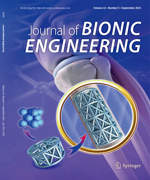
Journal of Bionic Engineering
ISSN 1672-6529
CN 22-1355/TB
Editor-in-Chief : Luquan Ren Published by Science Press and Springer
Online Journal
 Table of Content
Table of Content
Journal of Bionic Engineering
ISSN 1672-6529
CN 22-1355/TB
Editor-in-Chief : Luquan Ren Published by Science Press and Springer
 Table of Content
Table of Content